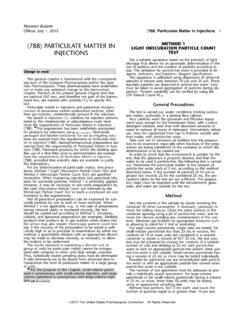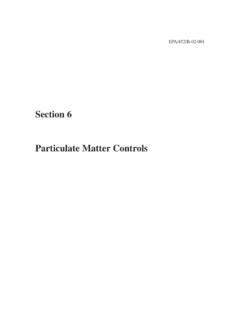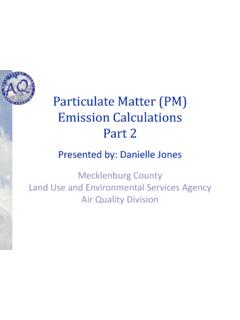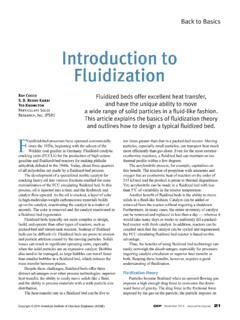Transcription of PM2.5 Chemical Composition - US EPA
1 The Chemical Composition of support PM ImplementationNeil FrankAQAG/AQAD USEPAFor Presentation at EPA State / Local / Tribal Training Workshop: PM Final Rule Implementation and 2006 PM Designation ProcessJune20-212 Topics How do we derive FRM How does avg Composition vary by region, by season and over time Variation within urban areas What are the local vs regional components and how does this relate to potential emission sources Differences between peak day and average composition3 What is the Composition of and where does it come from?Major components Ammonium Sulfate Ammonium Nitrate Organic Carbonaceous Mass Elemental Carbon Crustal MaterialSO2 NOXD irect PMVOC+NH3 The chemistry is complicated and particle formationis dependent on other pollutants and atmospheric conditionsFrom: The Particle Pollution Report.
2 Current Understanding of Air Quality and Emissions through 20034To estimate urban Composition Use measurements from routine monitoring networks STN, SLAMS (=CSN) Make adjustments to represent FRM mass FRM mass does notequal the simple sum of the measured components[ = AmmSul + AmmNitr + OCM +EC + Crustal]5 Cleveland, OHNO3 , ALJFMAMJJASOND annavg6 Nitrate Study Sites, 2003 FRM doesn t retain all ambient nitratesMonthly and Annual Average NO3, 2003 STN (total bar)FRM (red bar and black line) SulfateNitrateTCMC rustalPassiveReconstructed Fine MassRCFM(reflects ambient)SANDWICH(reflects FRM )FRM Compared to Speciation Network Measurements Less Nitrate Includes particle bound water Carbon achieves mass balanceand reflects all needed mass alsoincludesparticle bound water(at mass weighing conditions)6 SANDWICH more than a cute acronym What is the SANDWICHA pproach?
3 Sulfate, Adjusted Nitrate, Derived Water, Inferred Carbon Hybrid material balance approach for estimating mass Composition as if it was measured by the FRM. The approach uses a combination of speciation measurements and modeled speciation estimates to represent FRM Why is it needed? The FRM defines the regulatory indicatorof FRM mass may not retain all nitrate, and includes particle bound water and other components not estimated directly with STN measurements. To estimate FRM including FRM carbonaceous mass without fudge factors. To help QC speciation measurements SANDWICH is the default method in EPA modeling guidance to define baseline for SMAT (speciated modeled attainment test) FRM Composition with the peer-reviewed SANDWICH technique used in CAIR and , N.
4 Retained Nitrate, Hydrated Sulfates, and Carbonaceous Massin Federal Reference Method Fine Particulate matter for Six Eastern Cities,J. Air & Waste Manage. Assoc. 56:500 5117(a) W. Reduced Nitrates(b) With added waterSO4 UnknownCrustalpassiveTCMNO3(c) Plus filter contamination (= FRM blank )(d) Remaining unknown mass is assigned to carbon(1) Approachusing measurementsand calculated valuesConceptual Overview of Mass Balance Approaches*Distributeunknown(or scale all down) equally* Default SANDWICH can be modified to consider other components, like salt. This reduces estimate of TCM.(2) SANDWICHS ulfate mass increases8 RCFMSANDWICHA nnual Average Composition (2002-04) in East NA areasLess nitrate and more sulfate mass with SANDWICHNA area without STN data (02-04)Black outlined pies had collocated FRM and speciationareaarea_annual_dvNA area: Johnstown, area: Martinsburg, WV-Hagerstown, area: Parkersburg-Marietta, area: Reading, area: Steubenville-Weirton, OH-WV17NA area.
5 Wheeling, WV-OH Average Composition (2002-04) in West NA areasLess nitrate and more carbon mass with SANDWICHB lack outlined pies have collocated FRM and speciation1023456789101112 Riverside-San Bernardino,CA site= 060658001 (2005) and Components, ug/m30 60 Rubidoux, CA (2005)RCFMSANDWICHFRM massLess nitrate massMore sulfate and carbonGray line shows {OCMmb - OCM14}ChemSulfate_massNitrate_massECOCMm bCrustalPassiveOver-estimates FRM massFRM Composition can be very different than constructed mass from speciation and Components, ug/m30 60 Less nitrate massMore sulfate and carbonBirmingham, AL (2005)Under-estimates FRM massBirmingham,AL site= 010732003 (2005)
6 Gray line shows {OCMmb - OCM14}ChemSulfate_massNitrate_massECOCMm bCrustalPassiveFRM Composition can be very different than constructed mass from speciation measurements12Q1Q3Q2Q4 Sulfate_massNitrate_massTCMU nknown_at_DV_siteCrustalPassiveQuarterly Composition in Eastern NA areas, 2002-04 Note: Many areas do not have speciation data and some at a different siteNo speciationdata in 2002-0413Q1Q3Q2Q4 Sulfate_massNitrate_massTCMU nknown_at_DV_siteCrustalPassiveQuarterly Composition in NA areas, 2002-04 Many areas do not have speciation data and some at a different siteZOOM14Q1Q3Q2Q4 Sulfate_massNitrate_massTCMU nknown_at_DV_siteCrustalPassiveQuarterly Composition in Western NA areas, 2002-041stand 4thquarters have higher concentrations (except LA)
7 15 Composition Can Vary Within the NA Area Generally the extra component is carbonAllen Park airs_site_code=261630001 year= airs_site_code=261630033 year= PkDearbornSulfate sulfate, carbon and crustalFor some cities, there are gradients in non-C components16 Carbon, NO3 or Crustal?Baltimore (Essex speciation site) is not at DV site, 2002 speciation dataWhen DV site does not have speciation data, the unknown mass may or may not be TCMIt could be crustal material (as we observe in Birmingham and Detroit) or possibly NitrateWhat to do if speciation is not at the DV site?Accounting for differences in within-area speciation profilesSpeciation location (Ann Avg= ug/m3)NA area: Baltimore, MD - 240053001(2002-04) site ( ug/m3) ug/m3 is and component mass, 10 12 14 16 18 20 22 and component mass, 10 12 14 16 18 20 22 and component mass, 10 12 14 16 18 20 22 and component mass, 10 12 14 16 18 20 22 and component mass, 10 12 14 16 18 20 22 and component mass, 10 12 14 16 18 20 22 24 Regional Trends in Composition , 2002-2006 Compositional changes in some regionsLower nitrates and CarbonReduced Nitrates, Sulfates & CarbonNo change Sulfates.
8 Decreasing NitratesIncreasing CarbonLower nitrates and sulfatesLower nitrates and sulfatesLower nitrates and sulfates02 03 04 05 0602 03 04 05 0602 03 04 05 0602 03 04 05 0602 03 04 05 0602 03 04 05 06 Sulfate_massNitrate_massECOCMmbCrustalPa ssiveDRAFT18 SANDWICH data are now available on Air Urban Excess20 Urban Composition , ~17ug/m3 SulfateEstimated AmmoniumNitrateTCMC rustal+Urban Increment~6ug/m3 Regional Contribution~11ug/m3 Urban is Composed of Urban and Regional Components36%26%54%47%10%33%12%21%17%5%1 1%16%Baltimore compared toUpwind rural site illustrates urban/rural contributionsBased on constructed mass (not SANDWICH), March 01 Feb 0221 From Particle Pollution Report, 2003 Comparing single urban and rural locationsSulfates Most from regional sourcesUrban is Composed of Urban and Regional ComponentsCarbon Large component Local contribution (40-70%)Nitrates 10-30% of Some east avg.
9 Ambient nitrates~4 ug/m3 Local contribution >50%22 Carbon and Nitrates dominate the average local urban excessComposition of Eastern Non-Attainment AreasEstimated CompositionEstimated Urban Excess* Indicates areas with > 30% UE nitrates0%20%40%60%80% 100%York, ; Harrisb, PAWashington, DCSt, Louis, MO-IL* Reading, LancasterPA;Pittsb, WheelingPhiladelphia, New York, NY-NJ-CTLouisville, KY-INKnoxville, KY* Indianapolis, INHickory, NCGreensboro, NC* E vansville, IN-K Y* D etroit, MIC olumbus, OH; * Cleveland, OHC incinnati, OH-K Y-INChicago,IL-IN-WI; Chattanooga, TN-GACharleston, Hngtn,WV;* Canton, Steuben OH/WVBirmingham, ALBaltimore, MDA tlanta, GA ; Macon, GACarbonSulfatesNitratesCrustal0%20% 40% 60% 80% 100%York, ; Harrisb, PAW ashington, DCSt, Louis, MO-ILReading, LancasterPA;Pittsb, W heelingPhiladelphia, New York, NY-NJ -CTLouisville, KY-INKnoxville, KYIndianapolis, INHic kory , NCGreensboro, NCEvansville, IN-KYDetroit, MIColumbus, OH; Cleveland, OHCincinnati, OH-KY-INChicago,IL-IN-W I; Chattanooga, TN-GACharleston, Hngtn,W V;Canton, Steuben OH/W VBirmingham, ALBaltimore, MDAtlanta, GA; Macon, GACarbon Sulfates Nitrates Crustal 23 High Day vs.
10 Average CompositionAverage Concentration is based on all days but is strongly influenced by the highest concentration days24 Composition on Annual Average and High Days Some source categories and regional influences may be more important for high concentration days Comparing average of 5 highest days during 2003, regional sources of sulfates and nitrates are larger contributors to peak day concentrations than to annual average (selected city analysis) Composition can vary from high day to high day Carbon can be smaller as % -- but still larger in absolute concentration values -- compared















